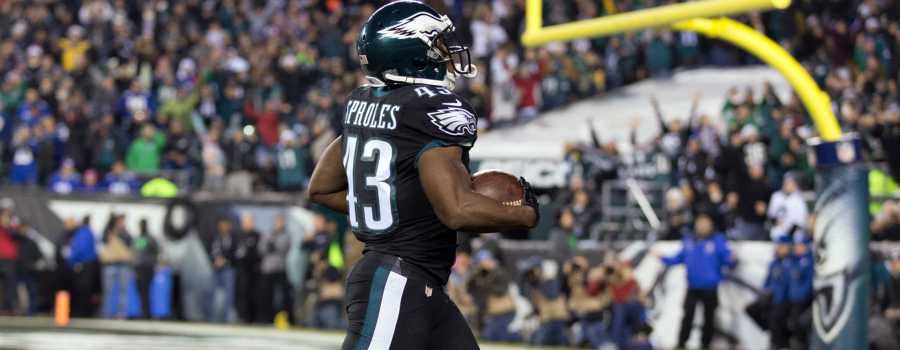The Highlights:
- The most productive featured backs have largely been tall, heavy, and young.
- Older featured backs can still be useful in DFS tournaments because they tend to carry low ownership.
- The most valuable space backs have generally been short, light, and old.
There exists an endless supply of notions as it pertains to running backs that are grounded in nothing more than common sense: the idea that tall running backs are inferior to short backs because they offer a larger target to hit, or that small running backs are less adept at running between the tackles compared to large backs who can take a pounding, or that young players will always offer more juice than older vets.
Identifying trends for factors such as height, weight, and age are useful because they can be applied to any and every running back. Let’s see how running backs of different sizes and ages have produced on DraftKings and FanDuel over the past four seasons. Using our NFL Trends tool, we’ll investigate running back fantasy success by age, height, and weight. We’ll compare fantasy points per game, Plus/Minus (points above/below salary-based expectation), ownership, and Consistency (percentage of time meeting salary-based expectations) for each of the three fantasy-friendly running back archetypes:
- Featured backs: Backs that averaged at least 20 carries plus targets per game (min. four games).
- Space backs: Backs that averaged at least three targets but fewer than 10 carries per game (min. four games).
- Early-down backs: Backs that averaged over 10 carries but fewer than three targets per game (min. four games).
Running backs will be grouped into the following buckets:
- Height: 5-foot-9 and below, 5-foot-10 to 5-foot-11, and 6 feet or greater.
- Weight: Under 210 pounds, 210-220 pounds, and greater than 220 pounds.
- Age: 24 or younger, 25-29, 30-plus.
Featured backs
For the most part, taller, bigger, and younger backs have comprised the league’s featured backs, but three-down backs of all shapes and sizes have largely excelled thanks to their workhorse role:

(For reference, running backs with a salary of at least $4,000 on DraftKings have averaged 11.3 fantasy points per game, a +0.62 Plus/Minus, 45.4% Consistency, and 6.3% ownership since 2014; running backs with a salary of at least $5,000 on FanDuel have averaged 9.6 fantasy points per game, a +0.52 Plus/Minus, 44.1% Consistency, and 5.1% ownership.)
We see three interesting takeaways from the data:
- Short and small running backs have delivered the most value, although they’ve been rare in recent seasons, with Devonta Freeman, Doug Martin, and Mark Ingram the only backs standing 5-foot-9 or shorter to work as featured backs since 2014. Freeman, Andre Ellington, and Kareem Hunt have been the only three-down backs to weigh fewer than 210 pounds.
- Age might not be anything but a number, but our group of featured backs older than 29 consists of just Adrian Peterson and Matt Forte. While their production and consistency understandably wasn’t on par with their younger cohorts, they did provide a steep ownership discount. Targeting older three-down backs in plus-matchups could give you exposure to 20-plus touches without a steep ownership premium.
- Taller and larger backs have provided plenty of consistency and value to go along with top-tier production, though they do come with high ownership rates.
Space Backs
The size disparity between receiving backs hasn’t been as big as some might think, as there has been the same amount of receiving backs standing 6 feet tall or more as those under 5-foot-10, but smaller and lighter receiving backs have generally been the cream of the crop:

A receiving role for an undersized back helps to limit wear and tear, and when they are on the field they’ve exceeded expectations more often than larger and taller receiving backs.
As far as age, our group of receiving backs older than 30 is limited to Forte, Darren Sproles, Pierre Thomas, and Danny Woodhead, who have largely dominated in this role compared to their younger counterparts, offering not only increased value but also an ownership discount.
Small and old running backs aren’t exactly the most enthralling fantasy assets to get behind, but both groups have historically offered reduced ownership with heightened consistency compared to young and tall backs. These backs often carry low price tags and are ideal targets in situations when a pass-heavy game flow is expected.
Early-Down Backs
As was the case with our draft round study, running backs without a defined receiving role have struggled to offer any upside to fantasy investors:

None of the groups have managed to meet their salary-implied total in even half of their games. Some similarities remain the same (older backs have continued to offer reduced ownership, big and tall backs have performed better in a run-heavy role), but it’s tough to get behind these one-dimensional backs in DFS.
Have more questions about DFS running back value? You can use our tools to research different types of backs yourself, and be sure to check out The Action Network for more in-depth NFL analysis.
More Fantasy-Friendly Running Back Archetype Coverage
- 3 Fantasy-Friendly Running Back Archetypes
- Using NFL Draft Round to Find Running Back Value
- Using Quarterback and Offensive Line Ability to Find Running Back Value
- Using Combine Metrics to Find Running Back Value (coming soon)
Pictured: Darren Sproles
Photo Credit: Bill Streicher – USA TODAY Sports





